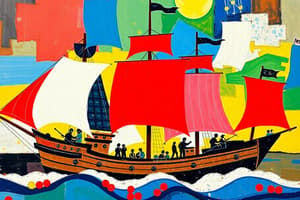Podcast
Questions and Answers
What was the result of the Eastern and Western Cherokee council meetings in June 1839?
What was the result of the Eastern and Western Cherokee council meetings in June 1839?
- The Cherokee people were forced to relocate to Indian Territory
- The Cherokee Nation was divided into two separate tribes
- The Cherokee Nation adopted a new constitution
- The Eastern and Western Cherokee adopted an 'Act of Union' and became one body (correct)
Study Notes
Early European Explorers
- Vasco da Gama, a Portuguese navigator, discovered the ocean trade route from Europe to India in 1498
- Da Gama sailed around Africa and was given the title "Admiral of the Indian Ocean" along with a fleet of twenty warships
- Amerigo Vespucci, an Italian navigator, sailed along the coast of South America in 1499 and became convinced that it was a new continent
- Martin Waldseemüller, a German cartographer, named the new land "America" in honor of Vespucci on his 1507 world map
- Ferdinand Magellan, a Portuguese explorer, led an expedition to circumnavigate the globe in 1519
- Magellan sailed west and found a passage through the southern part of South America, now known as the Strait of Magellan
- Magellan died in the Philippines in 1521, but one of his ships made it back to Spain in 1522, completing the first expedition to circle the globe
The Age of Exploration
- The quest for military, economic, and religious power motivated European countries to claim land in North America
- Europeans sought Native American tribes as allies because the tribes could provide protection and trade
- The French and Indian War was fought over who would control the Ohio River Valley
- The British policy of taxing the colonists without representation in Parliament eventually led to the American Revolutionary War
River Transportation
- Rivers were the best way to travel in Oklahoma during the early days
- Indians used rafts or dugout canoes made from trees found along the streams
- The principal waterways were the Arkansas, Verdigris, Grand, Cimarron, Canadian, and Red rivers
- Keelboats were used to carry heavy freight, and men used long poles or towlines to move the boats when the winds were unfavorable
The Louisiana Purchase
- The Louisiana Purchase was submitted to Congress as a treaty because it was a major land acquisition
- The U.S. government commissioned Meriwether Lewis and William Clark to explore the territory acquired in the Louisiana Purchase
- The Three Forks area was a significant trading post in Oklahoma
Seminole Removal
- The Seminole were the last of the Five Tribes forced into Indian Territory
- The Seminole resisted Spanish attempts to conquer them, as well as British and American efforts to take their Florida lands
- The First Seminole War was fought from 1817 to 1818, and the Treaty of Ghent officially ended the war and restored and clarified U.S. boundaries
- The Seminole were forced to move to Indian Territory, and many died on the long journey
Studying That Suits You
Use AI to generate personalized quizzes and flashcards to suit your learning preferences.
Description
Test your knowledge of the early European explorers and their routes, including Columbus, Cabot, Magellan, and da Gama. Identify the number of voyages shown on the map and learn about the discovery of the ocean trade route from Europe to India.




